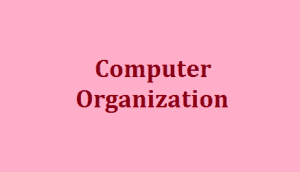Here you can download the free lecture Notes of Computer Organization Pdf Notes – CO Notes Pdf materials with multiple file links to download. The Computer Organization Notes pdf (CO pdf) book starts with the topics covering Basic operational concepts, Register Transfer language, Control memory, Addition and subtraction, Memory Hierarchy, Peripheral Devices, Characteristics of Multiprocessors, etc.

Computer Organization Pdf Notes – CO Notes Pdf
Unit 1
Link – CO Unit 1
Unit 2
Link – CO Unit 2
Unit 3
Link – CO Unit 3
Unit 4
Link – CO Unit 4
Unit 5
Link – CO Unit 5
Unit 6
Link – CO Unit 6
Unit 7
Link – CO Unit 7
Unit 8
Link – CO Unit 8
Computer Organization Pdf Free Download
UNIT-I
BASIC STRUCTURE OF COMPUTERS: Computer Organization pdf Notes
Computer Types, Functional units, Basic operational concepts, Bus structures, Software, Performance, multiprocessors and multi computers. Data types, Complements, Data Representation. Fixed Point Representation. Floating – Point Representation. Error Detection codes, Parallel Processing,
UNIT-II
REGISTER TRANSFER LANGUAGE AND MICROOPERATIONS: Computer Organization pdf Notes
The Register Transfer language. Register Transfer, Bus and memory transfer, Arithmetic Micro operations, logic micro operations, shift micro operations, Arithmetic logic shift unit. Instruction codes. Computer Registers Computer instructions – Instruction cycle. Memory – Reference Instructions. Input – Output and Interrupt. CENTRAL PROCESSING UNIT – Stack organization. Instruction formats. Addressing modes. DATA Transfer and manipulation. Program control. Reduced Instruction set computer
UNIT-III
MICRO PROGRAMMED CONTROL: Computer Organization pdf Notes
Control memory, Address sequencing, micro program example, Design of control unit-Hard wired control. Micro programmed control
UNIT-IV
COMPUTER ARITHMETIC : Computer Organization pdf Notes
Addition and subtraction, multiplication Algorithms, Division Algorithms, Floating – point Arithmetic operations. Decimal Arithmetic unit, Decimal Arithmetic operations.
UNIT-V
THE MEMORY SYSTEM : Computer Organization pdf Notes
Memory Hierarchy, Main memory, Auxiliary memory, Associative memory, Cache memory, Virtual memory, Memory management hardware
UNIT-VI
INPUT-OUTPUT ORGANIZATION : Computer Organization pdf Notes
Peripheral Devices, Input-Output Interface, Asynchronous data transfer Modes of Transfer, Priority Interrupt, Direct memory Access, Input –Output Processor (IOP), Serial communication
Computer Organization Notes – CO Pdf
UNIT-VII
PIPELINE AND VECTOR PROCESSING: Computer Organization pdf Notes
Parallel Processing, Pipelining, Arithmetic Pipeline, Instruction Pipeline, RISC Pipeline Vector Processing, Array Processors.
UNIT-VIII
MULTI PROCESSORS:
Characteristics of Multiprocessors, Interconnection Structures, Inter processor Arbitration. Inter processor Communication and Synchronization, Cache Coherence.

TEXT BOOKS to be referred : 1. Computer System Architecture – M.Moris Mano, IIIrd Edition, PHI / Pearson, 2006. 2. Computer Organization – Car Hamacher, Zvonks Vranesic, Safwat Zaky, V Edition, McGraw Hill, 2002.
Note :- These notes are according to the r09 Syllabus book of JNTUH. In R13 ,8-units of R09 syllabus are combined into 5-units in r13 syllabus. Click here to check all the JNTU Syllabus books
Frequently Asked Questions
Q1: What is the function of computer?
A1: The basic function performed by a computer is execution of a program, which consists of a set of instructions stored in memory.

Q2: What is a bit?
A2: Bit is usually a shortened form of “Binary digit”. It is common to avoid or neglect the fact that a bit represents the state of a switch. Hence simply call the switches as “bits.” A bit represents the state of an on-off switch.Using bits (binary digits), we can greatly simplify the previous statement about switches as 1101, which you can think of as representing “on, on, off, on.”. While representing, it does not matter whether we use 1 to represent “on” and 0 as “off,” or 0 as “on” and 1 as “off”. Everyone simply needs to be consistent.
Q3: What is a bus?
A3: A bus is a communication pathway connecting two or more devices. Shared transmission medium is a a main characteristic of a bus. A bus will be connected by multiple devices. A signal transmitted by any one device will be available for reception by all other devices attached to the bus. In case, if two devices transmit during the same time period, their signals will overlap and become distorted. Therefore, only one device can successfully transmit at a time . Generally, a bus consists of multiple communication lines or pathways. Each pathway is capable of transmitting signals representing the binary 1 and the binary 0. An 8-bit unit of data will be transmitted over eight bus lines. A system bus connects major computer components (processor, memory, I/O).
Q4: What is the difference between Minimal sum of products (mSoP) and minimal product of sums (mPoS)?
A4: Minimal sum of products (mSoP): A sum of products expression is minimal if all other mathematically equivalent SoPs
1. have at least as many product terms, and
2. those with the same number of product terms have at least as many literals.
Minimal product of sums (mPoS): A product of sums expression is minimal if all other mathematically equivalent PoSs
1. have at least as many sum factors, and
2. those with the same number of sum factors have at least as many literals.
These information imply that there can be more than one minimal solution to a problem.
